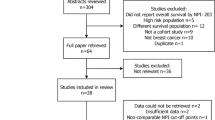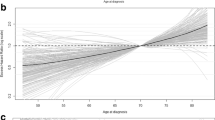Abstract
Purpose
Propensity trimming, hierarchical modelling and instrumental variable (IV) analysis are statistical techniques dealing with confounding, cluster-related variation or confounding by severity. This study aimed to explain (dis)advantages of these techniques in estimating the effect of breast-conserving therapy (BCT) and mastectomy on 10-year distant metastasis-free survival (DMFS).
Methods
All women diagnosed in 2005 with primary T1-2N0-1 breast cancer treated with BCT or mastectomy were selected from the Netherlands Cancer Registry. We used multivariable Cox regression to correct for confounding. Propensity trimming was used to create a more homogeneous population for which the treatment choice was not self-evident. Hospital of surgery was used as hierarchical level to handle hospital-related variation, and as IV to deal with unmeasured confounding.
Results
Multivariable Cox regression showed higher 10-year DMFS for BCT than mastectomy [HR 0.70 (95% CI 0.60–82)]. Propensity trimming on the 10–90th and the 20–80th percentile of the propensity score distribution and hierarchical modelling showed similar HRs. IV analysis showed no significant difference between BCT and mastectomy.
Conclusion
Unmeasured confounding is very difficult to eliminate in observational research. We cannot conclude that BCT or mastectomy has a causal relationship with 10-year DMFS. It is crucial to critically evaluate all model’s assumptions, and to be careful in drawing firm conclusions.

Similar content being viewed by others
References
Aarts E, Dolan CV, Verhage M, van der Sluis S (2015) Multilevel analysis quantifies variation in the experimental effect while optimizing power and preventing false positives. BMC Neurosci 16:94
Agarwal S, Pappas L, Neumayer L, Kokeny K, Agarwal J (2014) Effect of breast conservation therapy vs mastectomy on disease-specific survival for early-stage breast cancer. JAMA Surg 149(3):267–274
Antman K, Amato D, Wood W, Carson J, Suit H, Proppe K et al (1985) Selection bias in clinical trials. J Clin Oncol 3(8):1142–1147
Austin PC (2017) A tutorial on multilevel survival analysis: methods: models and applications. Int Stat Rev. 85(2):185–203
Baiocchi M, Cheng J, Small DS (2014) Instrumental variable methods for causal inference. Stat Med 33(13):2297–2340
Boef AG, le Cessie S, Dekkers OM (2013) Instrumental variable analysis. Ned Tijdschr Geneesk. 157(4):A5481
Braitman LE, Rosenbaum PR (2002) Rare outcomes, common treatments: analytic strategies using propensity scores. Ann Int Med. 137(8):693–695
Brookhart MA, Wyss R, Layton JB, Sturmer T (2013) Propensity score methods for confounding control in nonexperimental research. Circ Cardiovasc Qual Outcomes. 6(5):604–611
Chavez-MacGregor M, Giordano SH (2016) Randomized clinical trials and observational studies: is there a battle? J Clin Oncol 34(8):772–783
Chen K, Liu J, Zhu L, Su F, Song E, Jacobs LK (2015) Comparative effectiveness study of breast-conserving surgery and mastectomy in the general population: a NCDB analysis. Oncotarget 6(37):40127–40140
Dekkers OM (2011) On causation in therapeutic research: observational studies, randomised experiments and instrumental variable analysis. Prev Med 53(4–5):239–241
Federspiel JJ, Anstrom KJ, Xian Y, McCoy LA, Effron MB, Faries DE et al (2016) Comparing inverse probability of treatment weighting and instrumental variable methods for the evaluation of adenosine diphosphate receptor inhibitors after percutaneous coronary intervention. JAMA Cardiol. 1(6):655–665
Fisher B, Anderson S, Bryant J, Margolese RG, Deutsch M, Fisher ER et al (2002) Twenty-year follow-up of a randomized trial comparing total mastectomy, lumpectomy, and lumpectomy plus irradiation for the treatment of invasive breast cancer. N Engl J Med 347(16):1233–1241
Fisher S, Gao H, Yasui Y, Dabbs K, Winget M (2015) Survival in stage I-III breast cancer patients by surgical treatment in a publicly-funded healthcare system. Ann Oncol 26(6):1161–1169
Fritz APC, Jack A, Shanmugaratnam K, Sobin L, Parkin DM, Whelan S (2000) International classification of diseases for oncology, 3rd edn. World Health Organization, Geneva
Giordano SH (2015) Comparative effectiveness research in cancer with observational data. Am Soc Clin Oncol Educ Book. pp e330–e335
Greenland S (2000) An introduction to instrumental variables for epidemiologists. Int J Epidemiol 29(4):722–729
Hartmann-Johnsen OJ, Karesen R, Schlichting E, Nygard JF (2012) Survival is better after breast conserving therapy than mastectomy for early stage breast cancer: a registry-based follow-up study of Norwegian women primary operated between 1998 and 2008. Ann Surg Oncol 22(12):3836–3845
Hernan MA, Robins JM (2006) Instruments for causal inference: an epidemiologist’s dream? Epidemiology 17(4):360–372
Hershman DL, Wright JD (2012) Comparative effectiveness research in oncology methodology: observational data. J Clin Oncol 30(34):4215–4222
Hofvind S, Holen A, Aas T, Roman M, Sebuodegard S, Akslen LA (2015) Women treated with breast conserving surgery do better than those with mastectomy independent of detection mode, prognostic and predictive tumor characteristics. Eur J Surg Oncol 41(10):1417–1422
Hutchins LF, Unger JM, Crowley JJ, Coltman CA Jr, Albain KS (1999) Underrepresentation of patients 65 years of age or older in cancer-treatment trials. New Engl J Med. 341(27):2061–2067
Hwang ES, Lichtensztajn DY, Gomez SL, Fowble B, Clarke CA (2013) Survival after lumpectomy and mastectomy for early stage invasive breast cancer: the effect of age and hormone receptor status. Cancer 119(7):1402–1411
Kjaersgaard MI, Parner ET (2016) Instrumental variable method for time-to-event data using a pseudo-observation approach. Biometrics 72(2):463–472
Mansournia MA, Altman DG (2016) Inverse probability weighting. Bmj 352:i189
Moossdorff M, van Roozendaal LM, Strobbe LJ, Aebi S, Cameron DA, Dixon JM et al (2014) Maastricht Delphi consensus on event definitions for classification of recurrence in breast cancer research. J Natl Cancer Inst. https://doi.org/10.1093/jnci/dju288
Morrow M, Jagsi R, Alderman AK, Griggs JJ, Hawley ST, Hamilton AS et al (2009) Surgeon recommendations and receipt of mastectomy for treatment of breast cancer. JAMA 302(14):1551–1556
Onitilo AA, Engel JM, Stankowski RV, Doi SA (2015) Survival comparisons for breast conserving surgery and mastectomy revisited: community experience and the role of radiation therapy. Clin Med Res 13(2):65–73
Siesling S, van de Poll-Franse LV, Jobsen JJ, Repelaer van Driel OJ, Voogd AC (2005) Trends and variation in breast conserving surgery in the southeast and east of the Netherlands over the period 1990-2002. Ned Tijdschr Genesk 149(35):1941–1946
Sobin LHWC (2002) International union against cancer, TNM classification of malignant tumours, 6th edn. Wiley, New York
Stukel TA, Fisher ES, Wennberg DE, Alter DA, Gottlieb DJ, Vermeulen MJ (2007) Analysis of observational studies in the presence of treatment selection bias: effects of invasive cardiac management on AMI survival using propensity score and instrumental variable methods. JAMA 297(3):278–285
Sturmer T, Wyss R, Glynn RJ, Brookhart MA (2014) Propensity scores for confounder adjustment when assessing the effects of medical interventions using nonexperimental study designs. J Int Med. 275(6):570–580
Tsuchiya A, Tsutsumi Y, Yasunaga H (2016) Outcomes after helicopter versus ground emergency medical services for major trauma–propensity score and instrumental variable analyses: a retrospective nationwide cohort study. Scand J Trauma Resusc Emerg Med. 24(1):140
van Maaren MC, de Munck L, Jobsen JJ, Poortmans P, de Bock GH, Siesling S et al (2016a) Breast-conserving therapy versus mastectomy in T1-2N2 stage breast cancer: a population-based study on 10-year overall, relative, and distant metastasis-free survival in 3071 patients. Breast Cancer Res Treat 160(3):511–521
van Maaren MC, de Munck L, de Bock GH, Jobsen JJ, van Dalen T, Linn SC et al (2016b) 10 year survival after breast-conserving surgery plus radiotherapy compared with mastectomy in early breast cancer in the Netherlands: a population-based study. Lancet Oncol. 17(8):1158–1170
van Maaren MC, Strobbe LJA, Koppert LB, Poortmans PMP, Siesling S (2018) Nationwide population-based study of trends and regionalvariation in breast-conserving treatment for breast cancer. Br J Surg 105(13):1768–1777
Veronesi U, Cascinelli N, Mariani L, Greco M, Saccozzi R, Luini A et al (2002) Twenty-year follow-up of a randomized study comparing breast-conserving surgery with radical mastectomy for early breast cancer. The New Engl J Med 347(16):1227–1232
Acknowledgements
The authors thank the registration team of the Netherlands Comprehensive Cancer Organisation (IKNL) for the collection of data for the Netherlands Cancer Registry.
Funding
This research did not receive any specific grant from funding agencies in the public, commercial, or not-for-profit sectors.
Author information
Authors and Affiliations
Corresponding author
Ethics declarations
Conflict of interest
The authors declare that they have no conflicts of interest.
Additional information
Publisher's Note
Springer Nature remains neutral with regard to jurisdictional claims in published maps and institutional affiliations.
Rights and permissions
About this article
Cite this article
van Maaren, M.C., le Cessie, S., Strobbe, L.J.A. et al. Different statistical techniques dealing with confounding in observational research: measuring the effect of breast-conserving therapy and mastectomy on survival. J Cancer Res Clin Oncol 145, 1485–1493 (2019). https://doi.org/10.1007/s00432-019-02919-x
Received:
Accepted:
Published:
Issue Date:
DOI: https://doi.org/10.1007/s00432-019-02919-x




